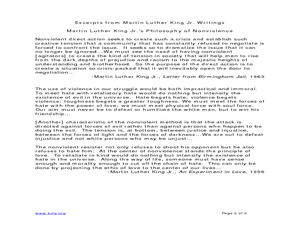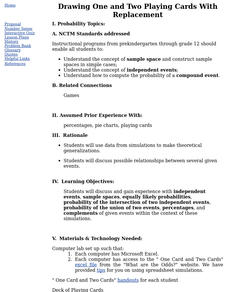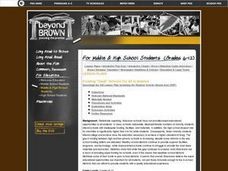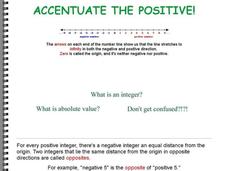Curated OER
Life in a Soviet Household
Students simulate the transaction costs experienced by the average householder in the former Soviet Union. They consider time spent searching and waiting in line, scarcity of goods and the lure of the black market.
Curated OER
African Americans in California’s Heartland – The Civil Rights Era
Events related to the Civil Rights Movement in Sacramento, California during the 1960s offer class members an opportunity to compare the nonviolent resistance approach favored by Dr. Martin Luther King and the NAACP with those of the...
Curated OER
The Civil Rights Act of 1964 and the Equal Employment Opportunity Commission
Young scholars discuss the Civil Rights Act of 1964 (and affirmative action) and how it has influenced American history in the decades since it's signing.
Curated OER
Being Equal is No Monkey Business
First graders study what an equation is before working to determine how to divide an odd number of items in an equitable way. They divide equations into those that are true and those that are not while two students act as the king and...
Curated OER
Gender Equity and Community Role Models
First graders listen to speakers in various professions. In this careers instructional activity, the teacher invites community members to speak to the class about their jobs and the education required, then students draw the conclusion...
Learning Games Lab
How to Use Oil Immersion Microscope
Teach the class how to use a microscope to identify bacteria in food. Scholars explore the different parts of the microscope and learn how to determine total magnification. They walk step-by-step through the procedure of preparing slides...
Learning Games Lab
The pH Scale and Meter Calibration
What are the different ways to test for pH? First, scholars explore the pH scale and a common way to test for acidity and alkalinity. Then, they learn about the importance of pH in food safety and why variance in pH could potentially...
Equality and Human Rights Commission
Learning area 5: Job Done!
Four activities conclude a unit through discussion and activities inspired by reflection. Scholars revisit their storybook from the first unit. Self-portraits showcase thought bubbles with written statements. Groups write and perform a...
Shodor Education Foundation
Equation Solver
Solve your equation and prove it, too. Young mathematicians solve linear equations using an interactive. They must input a property to justify each step of their solutions.
Workforce Solutions
Newton's Laws
Two lessons explore the connection between energy transformation and a given job. In instructional activity one, small groups role-play a scenario that showcases the energy transformations that may take place during a job-specific task....
J. Paul Getty Trust
Tag: Whose Values
Get young people thinking about their lives and current topics of social justice, advocacy, gender, race, and identity. After examining several works by Barbara Kruger, participants select a tag with one of the questions printed on it,...
Curated OER
What Can You Find in the Cabinet?
Looking in the cabinet can be fascinating! Examine the various departments of the Executive Cabinet in this group research project, which jigsaws so each small group has a different department and presents to the class. Groups create...
Curated OER
Drawing One and Two Playing Cards With Replacement
Math whizzes use data from simulations to make theoretical generalizations and discuss possible relationships between several given events. They use a simple card game to generate data to be analyzed.
Curated OER
Grab Bags
Eighth graders graph two inequalities with a single variable. They include drawing the intersection or union of inequalities on a number line. Students solve the linear equations using properties of equality and inequality. The lesson...
Curated OER
Funding "Great" Schools For All in America
Students use research skills and primary sources to complete a equal educational opportunities scavenger hunt activity in pairs. They locate key facts, examples, and information about the inequities in U.S. schools and create projects...
Curated OER
Why Nations Trade
Students discuss international trade focusing on opportunity cost and the principle of comparative advantage. They engage in a simulation activity based on different countries and their economic benefits.
Curated OER
WALK A MILE IN MY SHOES
Students explore educational opportunities available to people living in a variety of developing and more economically developed countries. They work in groups and research an assigned country and explore how society values education,...
Alabama Learning Exchange
The Five Senses: How They Relate to our World
Students explore the five senses and the significance of each sense. In this five senses and diversity lesson plan, students listen to You Can't Smell a Flower With Your Ear by Joanna Cole and take a walk observing opportunities to use...
Curated OER
Visualizing School Equity
Students examine how school segregation is affected by funding gaps. In this equity lesson plan,students read the article, "Crossing the Gap." Students analyze funding gaps between schools. Students understand that every students is...
Curated OER
Microfinancing Works for Local Citizens and Foreign Business
Learners define social responsibility. They describe examples of social responsibilities businesses have to society. Analyze special challenges in operations. Identify entrepreneurial opportunities available in international business.
Curated OER
Honing in on Hummingbirds
Young scholars explore ruby-throated hummingbirds. In this cross-curricular hummingbirds lesson, students listen to the book The Mystery of the Missing Hummingbirds and choose related topics to research with a partner. Young scholars...
Curated OER
Accentuate the Positive!
Students participate in an interactive online activity about adding, subtracting, multiplying, and dividing positive and negative integers. Students look at sample problems through out the activity and have the opportunity to complete ...
Curated OER
Code Crackers Math Game
Students, through this math game, are provided with opportunities to work with math operations and simple algebraic equations. They create a spreadsheet-based "rule machine."
Curated OER
The Game of Chance
Third graders use manipulatives to determine the probability of outcomes. In this probability lesson, 3rd graders roll dice and use spinners to determine the probability of outcomes. They determine if games are fair/unfair based on their...

























